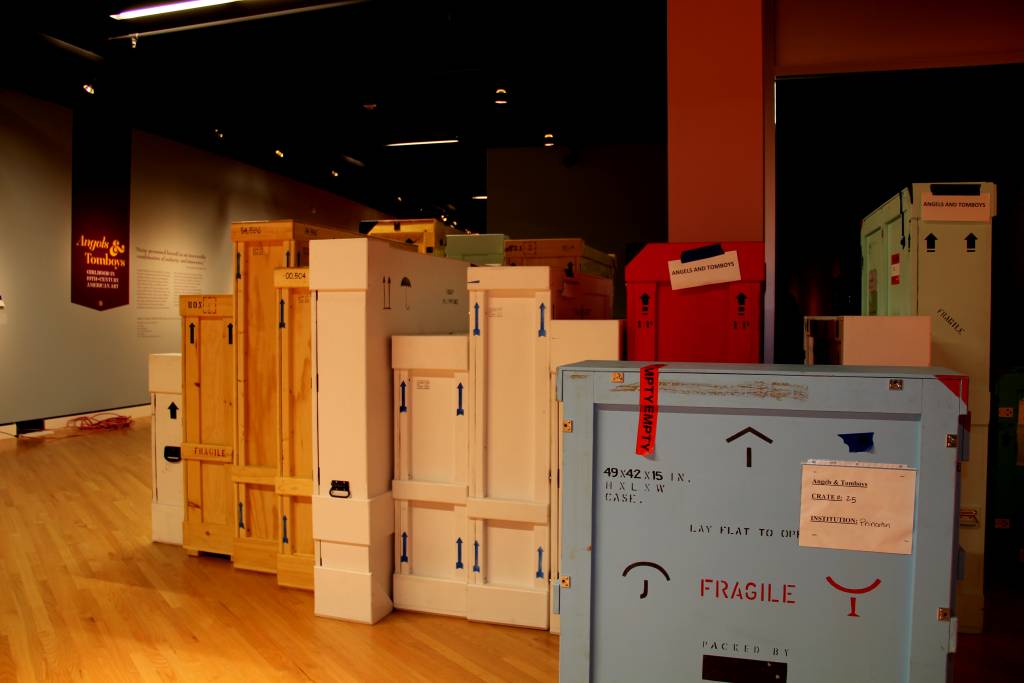How many people does it take to deinstall an exhibition? Sometimes a lot. For the take-down of the Angels & Tomboys: Girlhood in 19th-Century American Art exhibition it took ten couriers, six preparators, and one registrar seven days to pack and ship out sixty-four paintings, prints, and photographs and seven sculptures into fifty-nine crates on four shipments.

Newark Museum Collection Manager Jason Wyatt closely inspects an artwork from his museum prior to its deinstallation.
What is a courier and why are there so many? A courier is a representative of the lender of the artwork who is responsible for overseeing its care and condition. A courier is required if the object is fragile and/or has a high insurance value. Traveling to a lot of venues can put wear and tear on an object and it must be monitored accordingly. The main job of a courier is to assess the condition of the artwork by comparing its latest condition report to the object itself and looking for any changes. Is that a new bump on the canvas? Was that frame chipped before? Is that bubble gum? The condition report lists, in detail, any bumps, scratches, or irregularities on the object when it arrived. If there are any changes to the artwork, then the courier will note those changes on the report. If the changes are drastic and the object needs to be repaired immediately, then the courier will make a decision on what the next steps should be.
Because Crystal Bridges was the last stop on the three-venue exhibition tour of Angels & Tomboys, many of the lenders sent couriers to assess their objects before they were returned. Angels and Tomboys was a high insurance-value exhibition, and to help with the insurance cost, the exhibition was covered under the United States Arts and Artifacts Indemnity Program that is administered by the National Endowment for the Arts. One requirement of the program is that each shipment of artwork must have a courier on each truck. All of these factors contributed to our total number of ten couriers to de-install the exhibition.
The Angels & Tomboys exhibition was organized by the Newark Museum, so they had a representative here every day for deinstallation. In addition, we hosted one to three of the remaining nine couriers each day over the next seven days. Each day was a blur of condition-reporting and packing artwork and moving crates. Even though it is a production to schedule and host each courier and object deinstallation, it can actually be fun to meet different people from other museums and show them around our wonderful facilities.

Crates of artwork are lined up in the gallery, waiting to be shipped back to their lending institutions.
Why all the fun colors on the crates? A lot of museums have a specific color for their crates, so when you have an exhibition consisting of many different lenders, you can have a truck full of happy colors! The different colors help couriers easily identify their crate among large shipments so they can monitor it and make sure that it is being handled correctly by art handlers and transportation staff. This is especially important for international shipments, when the crate is being loaded on a plane. Sometimes bad things can happen with a forklift—so it is comforting to know immediately if that accident with a crate you just witnessed from the waiting area was your object or not!
The most challenging artwork to deinstall in the Angels & Tomboys exhibition was an 1871 marble sculpture by Chauncey Bradley Ives titled The Truant that was on loan from the New-York Historical Society. Because the sculpture weighed between 400 and 500 pounds, our Lead Preparator, Chuck Flook, felt the best way to move the sculpture from the pedestal to the crate was through the use of a gantry. A gantry is a type of crane with a hoist that allows an object to be lifted and moved from one side to another. In the photos you can see our prep team lifting the wrapped and padded sculpture and carefully placing it on the base of the crate. The prep team then proceeded to put the pieces of the crate back together around the sculpture.

The prep team lower the sculpture onto the base of its crate after removing it from the gallery pedestal.
After the last truck left with the artwork, we all took a five-minute break and started preparing for our next exhibition. Things are constantly in motion at the Museum and each day is a new adventure.






